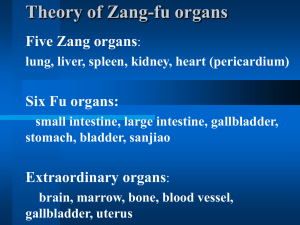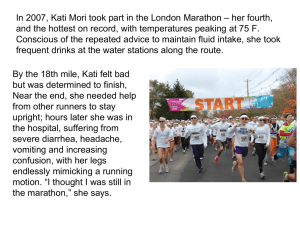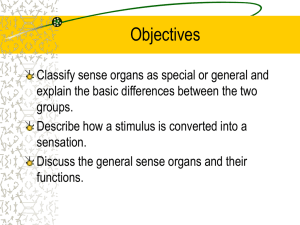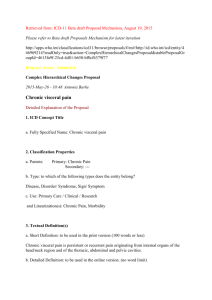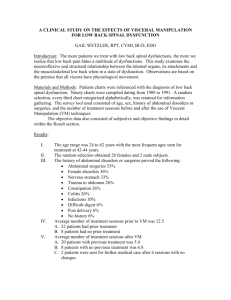Visceral Manipulation in the Chronic Pain Patient
advertisement
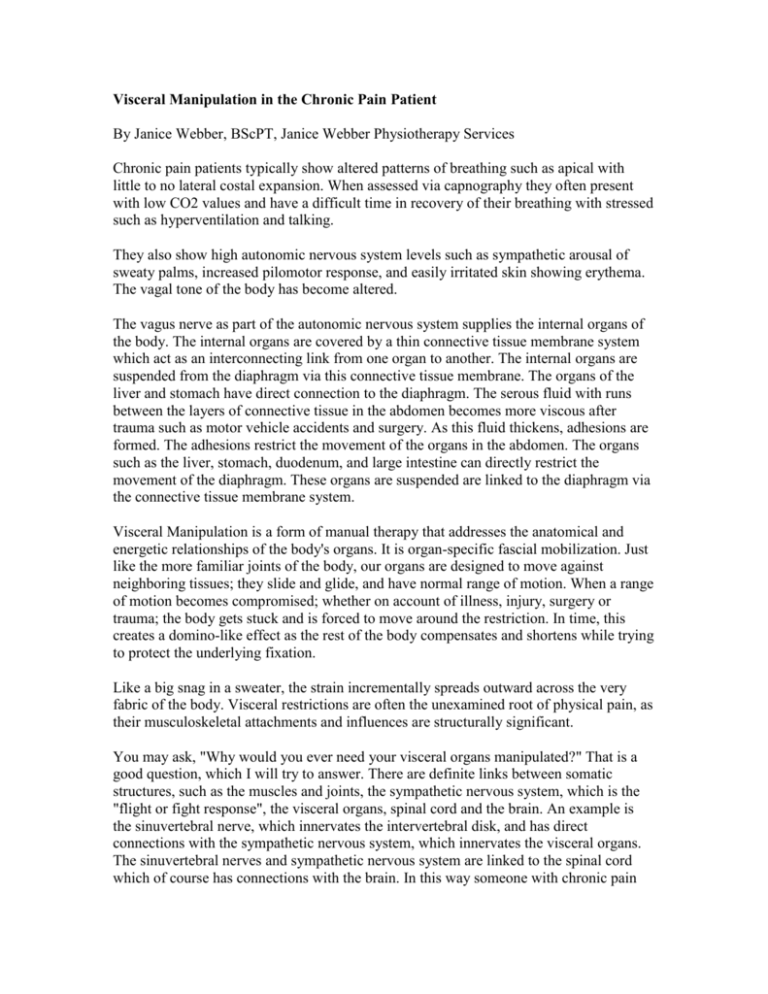
Visceral Manipulation in the Chronic Pain Patient By Janice Webber, BScPT, Janice Webber Physiotherapy Services Chronic pain patients typically show altered patterns of breathing such as apical with little to no lateral costal expansion. When assessed via capnography they often present with low CO2 values and have a difficult time in recovery of their breathing with stressed such as hyperventilation and talking. They also show high autonomic nervous system levels such as sympathetic arousal of sweaty palms, increased pilomotor response, and easily irritated skin showing erythema. The vagal tone of the body has become altered. The vagus nerve as part of the autonomic nervous system supplies the internal organs of the body. The internal organs are covered by a thin connective tissue membrane system which act as an interconnecting link from one organ to another. The internal organs are suspended from the diaphragm via this connective tissue membrane. The organs of the liver and stomach have direct connection to the diaphragm. The serous fluid with runs between the layers of connective tissue in the abdomen becomes more viscous after trauma such as motor vehicle accidents and surgery. As this fluid thickens, adhesions are formed. The adhesions restrict the movement of the organs in the abdomen. The organs such as the liver, stomach, duodenum, and large intestine can directly restrict the movement of the diaphragm. These organs are suspended are linked to the diaphragm via the connective tissue membrane system. Visceral Manipulation is a form of manual therapy that addresses the anatomical and energetic relationships of the body's organs. It is organ-specific fascial mobilization. Just like the more familiar joints of the body, our organs are designed to move against neighboring tissues; they slide and glide, and have normal range of motion. When a range of motion becomes compromised; whether on account of illness, injury, surgery or trauma; the body gets stuck and is forced to move around the restriction. In time, this creates a domino-like effect as the rest of the body compensates and shortens while trying to protect the underlying fixation. Like a big snag in a sweater, the strain incrementally spreads outward across the very fabric of the body. Visceral restrictions are often the unexamined root of physical pain, as their musculoskeletal attachments and influences are structurally significant. You may ask, "Why would you ever need your visceral organs manipulated?" That is a good question, which I will try to answer. There are definite links between somatic structures, such as the muscles and joints, the sympathetic nervous system, which is the "flight or fight response", the visceral organs, spinal cord and the brain. An example is the sinuvertebral nerve, which innervates the intervertebral disk, and has direct connections with the sympathetic nervous system, which innervates the visceral organs. The sinuvertebral nerves and sympathetic nervous system are linked to the spinal cord which of course has connections with the brain. In this way someone with chronic pain can have irritations and facilitated areas not only in the musculoskeletal system (including joints, muscles, fascia, and disks) but also the visceral organs (including the liver, stomach, gallbladder, intestines and adrenal glands), the peripheral nervous system, the sympathetic nervous system and even the spinal cord and brain. I think that attempting to discover each patients primary, or at least their least secondary problem or lesion is ultimately what we would all like to do. I feel if we are doing this, then we have a chance to be working on where the problem is located and subsequently giving the patient a better result. With my own training, which is ongoing, I am able to many times locate the primary physical restriction, or primary lesion. I do this with a technique, Visceral Listening, which was developed by Jean-Pierre Barral, DO. This technique involves listening to the patient's body with your palpating hand and feeling for the line of tension in the body. It is not a metaphysical type sensation. It is a direct physical line of pull that with instruction and much practice, is something that anyone can learn. In this way the practitioner can allow the body to reveal where the problems are located and which ones are more primary. The osteopaths have some sayings that I find useful and they are, " Only the tissues know" and "Let the body speak". The reason I find this type of evaluation so effective is that the body is much too complicated to "figure it out" with our heads; especially with chronic problems that have resisted treatment. But I have found that the story is all there in the patient's body if you allow yourself to listen to it. A final thought: I believe that each patient has an inherent ability to heal and function in good health. We don't "fix" the patient as much as we take away the reason their body is not functioning well. Then, their body actually does the healing. I think this shows respect for each individual's body and soul, and allows a more complete healing. This is a philosophy, based in osteopathy, that I have found useful in my daily practice as a physical therapist.




